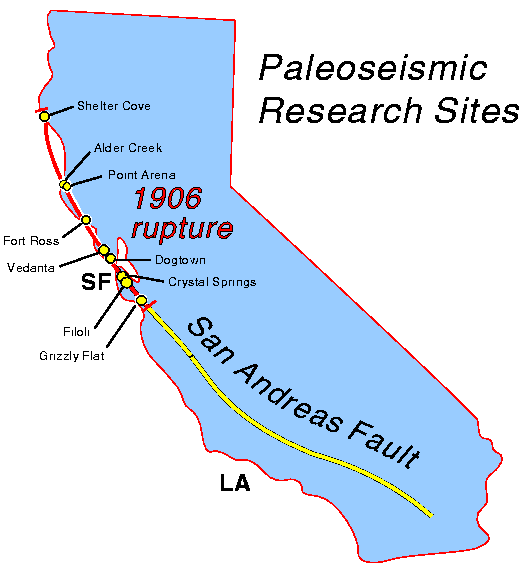The 1906 earthquake was accompanied by nearly 300 miles of surface rupture along the San Andreas Fault between San Juan Bautista and Shelter Cove. On the surface, the maximum measured displacement was about 21 feet, near Olema. The fault moved in a fashion that geologists of the time did not expect: it moved horizontally, the southwestern side slipping to the northwest, relative to the southeastern side. The offsets measured across the fault in other locations were smaller than the offset near Olema. Near Point Arena it was about 15 feet. South of San Francisco, it was about 9 feet, and dropped off to the southeast.
Paleoseismology has helped geologists to learn more about the behavior of the fault in 1906 and in prehistoric earthquakes. Paleoseismology involves the geologic study of the past behavior of active faults. Typical methods include excavating trenches across active faults to study and date the sediments that have been disrupted by prehistoric earthquakes. Results of these studies include constraints on the timing of prehistoric earthquakes, the amount of offset, and how fast the fault is moving, on the average, over geologic time (slip rate). More information about the geologically recent past behavior of active faults allows better forecasts of their future behavior.

Map showing the 1906 rupture of the San Andreas fault.
| Site | Slip Rate | Events | Researchers |
|---|---|---|---|
| Shelter Cove | evidence that reported ground ruptures in 1906 were due to fault slip (1906 reports have been controversial) | Prentice, Merritts, Bodin and Beutner | |
| Alder Creek | 17 ± 4 mm/yr (min) | Baldwin and Prentice | |
| Point Arena | 23 ± 2 mm/y (max) | > 5 in 2 ka penultimate event after AD 1635 | Prentice and Sieh |
| Ft Ross | 19–22 mm/y | 6 in 2.5–3.0 ka | Noller et al. |
| Olema | 24 ± 3 mm/y (min) | Niemi and Hall | |
| Crystal Springs | Old estimate: 12 ± 3 (min) Revised: highest minimum 8 mm/y | Hall | |
| Filoli | 15 ± 3 mm/y | evidence for 1838 earthquake | Clahan, Hall and Wright |
| Grizzly Flat | penultimate event pre AD 1650 | Shwartz et al. |
 Jump to Navigation
Jump to Navigation